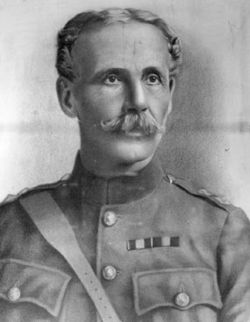- William Dillon Otter
-
Sir William Dillon Otter 
Born December 3, 1843
Corners (Clinton), Upper CanadaDied May 6, 1929 (aged 85) Allegiance Canada Service/branch Canadian Army. Rank General Commands held Chief of the General Staff Battles/wars Battle of Ridgeway during the Fenian Raids
Battle of Cut Knife
Battle of Paardeberg.Awards Knight Commander of the Order of the Bath
Commander of the Royal Victorian Order
Volunteer DecorationGeneral Sir William Dillon Otter KCB, CVO, VD (December 3, 1843 – May 6, 1929) was a professional Canadian soldier who became the first Canadian-born Chief of the General Staff, the head of the Canadian Army.
Contents
Military career
Born near the Corners (Clinton), Upper Canada, Otter began his military career in the Non-Permanent Active Militia in Toronto in 1864. Captain William Otter was Adjutant of The Queen's Own Rifles of Canada in 1866. He first saw combat with them at the Battle of Ridgeway during the Fenian Raids.
He joined the Permanent Force as an infantry officer when Canada established its own professional infantry unit in 1883. On May 2, 1885, he led a Canadian force of more than 300 in the Battle of Cut Knife against Poundmaker's Cree Indians. Otter's tactics were ineffective against the defending warriors, forcing him to retreat.
In 1890, Otter founded the Royal Canadian Military Institute as a body for "the promotion and fostering of military art, science and literature in Canada." The Gen Sir William Otter Papers are selected from those presented at events organized by the Defence Studies Committee of the Royal Canadian Military Institute.[1]
He was appointed as the first Commanding Officer of the Royal Canadian Regiment of Infantry in 1893.
Lieutenant-Colonel W.D. Otter commanded the Royal Canadian Regiment of Infantry, at the time of the Second Boer War. Otter commanded the 2nd (Special Service) Battalion of The Royal Canadian Regiment of Infantry in South Africa, where they were considered by many British officers to be the best infantry battalion in the country. He became the first Canadian-born officer to command Canada's military in 1908, and he retired in 1910. Otter had the reputation of being something of a martinet - due mainly to his desire that the young Canadian Army should not show up badly when compared to British troops.[2]
He wrote `The Guide: A Manual for the Canadian Militia (Infantry) Embracing the Interior Economy, Duties, Discipline, Drills and Parades, Dress, Books, and Correspondence of a Battalion with Regulations for Marches, Transport & Encampment, Also Forms & Bugle Calls` in 1914, which includes sections on discipline, courts martial, offences, complaints, and defaulters.
During the First World War he came out of retirement to command operations for the internment of enemy nationals resident in Canada.
Most famously though perhaps least well known of his accomplishments, Otter headed the Otter Commission. The Otter Commission was tasked to establish links of perpetuation from the units of Canadian Expeditionary Force back to the institutionally separate units of the Canadian Militia in the years following the First World War. This establishment of perpetuation, based primarily on geographical connections through original recruiting areas of the CEF battalions, provided a basis by which the achievements and battle honours of the CEF units transferred back to the units of the standing Militia. Without this work of the Otter Commission the CEF and its achievements would have had no continuance with existing units of the Canadian Army today.
Career
William Otter was initiated in Ionic Lodge in Toronto in February 1869. He became Wor. Master in 1873.[3]
Legacy
The Otter Squadron at the Royal Military College of Canada in Kingston, Ontario was named in his honour. ...
Family connections
Otter was the grandfather of Canadian Military historian Desmond Morton.
See also
References
- ^ Gen Sir William Otter Papers
- ^ Brian A Reid "Our Little Army in the Field - The Canadians in the Boer War"
- ^ http://sites.google.com/site/ionic025/notable-members/otter William Dillon Otter in Ionic Lodge
- Desmond Morton, The Canadian General Sir William Otter, Toronto: Hakkert, 1974. Canadian War Museum historical publication
- Commander Chas. N. Robinson R.N., Celebrities of the Army, London: George Newnes Limited, 1900.
- Major-General Sir William D. Otter `The Guide: A Manual for the Canadian Militia (Infantry) Embracing the Interior Economy, Duties, Discipline, Drills and Parades, Dress, Books, and Correspondence of a Battalion with Regulations for Marches, Transport & Encampment, Also Forms & Bugle Calls` Toronto: Copp, Clark & Co. 1914
External links
- Biography at the Dictionary of Canadian Biography Online
- Information from civilisations.ca
- Information on Otter and the Otter Committee at canadiansoldiers.com
Military offices Preceded by
Sir Percy LakeChief of the General Staff (Canada)
1908-1910Succeeded by
Sir Colin MackenzieGeneral Officers Commanding Edward Selby Smyth • Richard Luard • Frederick Dobson Middleton • Ivor Herbert • William Julius Gascoigne • Edward Hutton • Richard Hebden O'Grady Haly • Earl of Dundonald
Chiefs of the General Staff Percy Lake • William Otter • Colin Mackenzie • Willoughby Gwatkin • James MacBrien • Herbert Thacker • Andrew McNaughton • Ernest Ashton • Thomas Anderson • Harry Crerar • Kenneth Stuart • John Murchie • Charles Foulkes • Guy Simonds • Howard Graham • Samuel Clark • Geoffrey Walsh
Commanders, Mobile Command Jean Victor Allard • William Anderson • Gilles Turcot • William Milroy • Stanley Waters • Jacques Chouinard • Jean Jacques Paradis • Charles Belzile • James Fox • Kent Foster • Jim Gervais
Chiefs of the Land Staff Gord Reay • Maurice Baril • William Leach • Mike Jeffery • Rick Hillier • Marc Caron • Andrew Leslie • Peter Devlin
Categories:- 1843 births
- 1929 deaths
- Canadian generals
- Canadian knights
- Knights Commander of the Order of St Michael and St George
- Commanders of the Royal Victorian Order
- Recipients of the Volunteer Decoration
- People of the Fenian Raids
- People of the North-West Rebellion
- The Queen's Own Rifles of Canada
Wikimedia Foundation. 2010.
